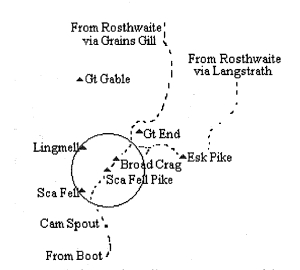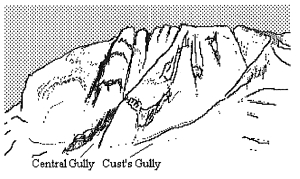Scouts and Outposts
Michael Smith
Arthur Evans brought to my attention Lehmann Oppenheimer’s 1908 book ‘Heart of Lakeland’, in response to a query concerning a ‘Scouts and Outposts’ activity on a meet. In one chapter Oppenheimer describes his experiences and those of a few friends on one such meet.

The game was developed by the Climbers’ Club from some sort of manhunting sport pursued by ‘Cambridge men’.
The Rules:
Duration: 10am to 3pm though Outposts may move into position earlier.
Players: Several Scouts, about two dozen Outpost ‘men’. Outposts wear white arm bands. Scouts wear red arm bands.
Aim: Scouts make their way to a target point without being ‘captured’ by the Outposts. Outposts seek to capture Scouts on the way to the target point without being put ‘out of action’ by the Scouts.
Areas: A fixed target point is designated, normally a peak top. The three quarters of a mile (1.2km) radius circle around that point is the exclusion zone. The zone is only open for access to Outposts after 2pm or when in hot pursuit of a Scout. A range of possible start points, well outside the exclusion zone, is agreed. Maps are supplied with the target, exclusion zone limit and start points all marked.
The playing area should be wild, rough ground to include ample cover and lookout points.
Organisation: The Captain of the Outposts deploys the Outposts, initially outside the exclusion zone. Scouts may work individually or in groups.
Capture: A Scout is captured when two Outposts, both within 100 yards of him, simultaneously call on him to surrender. A captured Scout plays no further part in the game but may make his way to the target.
Out of Action: An Outpost is put out of action by being touched by a Scout. An out of action Outpost plays no further active part in the game but follows the instructions of the Scout.
Strategies: If all the Outposts are close to the circle round the exclusion zone then they are about 300 yards apart. The use of some Outposts as lookouts sent towards the Scouts increases that separation but may give warnings that allow redeployment of Outposts to higher risk areas. Lookouts would identify Scouts and then fall back, ahead of the Scouts, to communicate with the other outposts. Lone and isolated Outposts are at greater risk of being put out of action.
Scouts need to balance cautious movement making use of available cover and unexpected routes with the need to move quickly enough to reach the target in time and allowing time to lie low if spotted but not captured. Concerted action by Scouts can weaken one part of the circle so reducing the risk of capture.
The weather affects visibility and communication and thus the strategies to be employed.
Scoring: Points are awarded:
To the Scouts
3 points for each uncaptured Scout reaching the target
1 point for each Outpost placed out of action
To the Outposts
3 points for each out of time or captured Scout.
Oppenheimer describes an event with Sea Fell Pike as the target and Wastdale Head, Boot and Rosthwaite as .the start points. The weather was unfortunately for the Scouts, bright and clear, a sunny day. He set off from Rosthwaite, heading for Great End, an obvious Outpost lookout point, with the sun directly into his face. Making use of what cover there was he went up Grains Gill, round the west shoulder of Great End and took the broken ground between the head of Skew Gill and the middle Pike
On reaching the top of Grains Gill he waited, below the edge, for a large party to come along and fell in with it. Unfortunately they soon stopped for lunch.
Hearing whistles near the west shoulder of Great End he realised that had been spotted and headed for the cover of Cust’s Gully. Near the top he met ice that, without an axe, he could not cross so descended and moved nearer to Central Gully. Resting at the top of this he peeped over the brim ready for the rush to the top of Great End.
Immediately on setting off he surprised a single outpost who had sent others down in search. Putting the outpost out of action they moved together along the path to towards Broad Crag.
The Captain who made for them as if to berate they for neglecting their posts then realised the situation and dashed off to avoid being put out of action and to start calling in support.
Well before the 2pm deadline he was within the circle and beyond all outposts except the Captain who was, of course, harmless on his own. Pushing on quickly he made the target with 1½ hours to spare.
The other Scouts from Rosthwaite took too long in going via Lang Strath and Esk Pike before splitting up before the exclusion zone then running out of time. The two from Boot sneaked past Cam Spout within earshot of Outposts and made it unchallenged to the top.
So the score was 10 to the Scouts and 6 to the Outposts.
Is it practicable nowadays?
